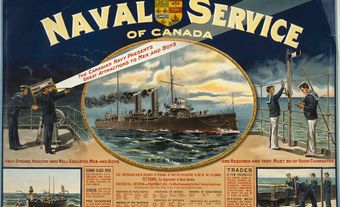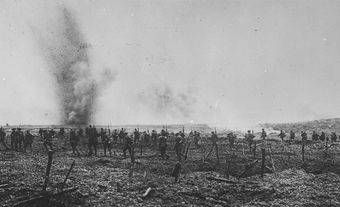In the Battle of Coronel, warships of the powerful German East Asiatic Squadron defeated a much weaker Royal Navy squadron. The battle was fought off the coast of Chile near the port city of Coronel on 1 November 1914. Four midshipmen of the Royal Canadian Navy went down with the British flagship. They were the first Canadians to die in battle during the First World War.

German East Asiatic Squadron
The German East Asiatic Squadron, which was based in the Chinese port of Tsingtao [Qingdao], protected the country’s interests in the Pacific region. By 1914, Germany (like Britain, France, Australia, New Zealand and the United States) had several colonial possessions in the Pacific, including parts of Samoa, New Guinea, Nauru, the northern Solomon Islands and the Marshall Islands.
Vice-Admiral Graf (Count) Maximilian von Spee commanded the squadron. It consisted of two modern armoured cruisers, Scharnhorst and Gneisenau, and three of the latest light cruisers, Emden (later replaced by Dresden), Leipzig and Nürnburg. The Scharnhorst and Gneisenau were each equipped with eight 8.2-inch guns and six 6-inch guns, while the light cruisers had ten 4-inch guns each.

When Britain declared war on Germany on 4 August 1914, von Spee’s squadron was at sea. He decided he could not defend Tsingtao or any of Germany’s Pacific islands. Instead, he chose to attack Allied merchant shipping off the west coast of South America. He headed for Valparaiso, Chile, where a large German immigrant population could help provide intelligence and supplies, especially coal.
British Response
Although the Allies were not sure what von Spee planned, they feared he would attack merchant shipping in the South Pacific and eventually the South Atlantic. The British Admiralty therefore established a South American Squadron under Rear-Admiral Sir Christopher Cradock. The ships of Cradock’s new squadron were a mixed lot and generally inferior to the German squadron.

Cradock’s flagship was HMS Suffolk, but the Admiralty ordered him to change it to the armoured cruiser HMS Good Hope. While Good Hope was sailing from Britain to Halifax, Nova Scotia, for the transfer, Suffolk was there coaling on 13–14 August. Seven Royal Canadian Navy (RCN) midshipmen — popularly known as “middies” — volunteered to join the ship. For some reason, Cradock did not wait for Good Hope, and Suffolk left on 14 August.
Good Hope arrived in Halifax on 15 August and departed the same day to catch up to Suffolk. When that happened, Cradock was rowed across from one warship to the other. Four RCN midshipmen were also transferred to Good Hope.

Did you know?
The four Canadian midshipmen on HMS Good Hope were recent graduates of the first class of Halifax’s Royal Naval College of Canada. British Admiral Christopher Cradock specifically asked for William Palmer of Halifax, who was first in his class, and Arthur Silver, also of Halifax, who had been senior cadet captain. Malcolm Cann of Yarmouth, Nova Scotia, and John Victor Hatheway of Fredericton, New Brunswick, were chosen by lot.
Good Hope’s armament consisted of two 9.2-inch guns in single turrets forward and aft, and sixteen 6-inch guns mounted in casemates that protruded from each side of the ship. The 6-inch guns were prone to flooding in heavy seas and were difficult to aim.
The other ships in Cradock’s squadron were HMS Glasgow, a modern lightly armoured cruiser; HMS Monmouth, a protected cruiser; and Otranto, a passenger liner converted into an armed merchant cruiser. Although Glasgow was the fastest of Cradock’s ships, its 6-inch guns were mounted the same way as Good Hope’s and suffered from the same weaknesses.

Battle of Coronel
Cradock sailed through the Strait of Magellan on 27 October and up the west coast of Chile to find the German squadron. At dusk on 1 November, the British intercepted the Germans 80 km from Coronel. Von Spee’s ships had greater speed and gun range, while the combined weight of their broadside was twice that of the British ships. Additionally, the crews of German cruisers Scharnhorst and Gneisenau had recently won their navy’s top gunnery award.
At 7:04 p.m., the big German cruisers opened fire with their 8.2-inch guns. The third salvo from Scharnhorst achieved a direct hit on Good Hope and knocked out its forward 9.2-inch turret. Meanwhile, Gneisenau’s second salvo scored a direct hit on Monmouth. Hit after hit followed on Good Hope and Monmouth. Within an hour, the two RN warships were ablaze and sank without survivors. More than 1,600 sailors were lost, including the four Canadian midshipmen. They were the first Canadian combat casualties of the First World War.
Glasgow and Otranto escaped and sent word of the loss. The Battle of Coronel marked the first defeat for the RN in more than a century. Not only did it shock the British public and the Admiralty, but it also increased the fears of British Columbians about a German naval attack against them.

Battle of the Falklands
The British wasted no time, quickly assembling a new and powerful squadron of two battle cruisers, four cruisers and Glasgow to stop Admiral von Spee’s squadron, which was heading for the South Atlantic. On 7 December, the British force gathered at Port Stanley in the Falkland Islands to recoal before heading into the Pacific in search of the German squadron.
The next day, the German squadron was sighted. Most of the British ships were coaling, so they could not immediately pursue von Spee as he fled southeast. After two hours, the two battle cruisers, Invincible and Inflexible, left port; they were much faster than the German warships and soon caught up to von Spee. Using their 12-inch guns, they sank Scharnhorst and severely damaged Gneisenau, whose captain scuttled his ship. At about the same time, the other British cruisers sank Leipzig and Nürnberg as they headed south.
Dresden managed to escape back into the Pacific Ocean. Rather than face battle, the ship’s crew scuttled it when they spotted two British cruisers on 14 March 1915. Of the approximately 2,200 German sailors aboard the four warships that had been sunk, only 215 were rescued. The threat of German surface ships to Allied merchant shipping had been eliminated.


 Share on Facebook
Share on Facebook Share on X
Share on X Share by Email
Share by Email Share on Google Classroom
Share on Google Classroom




